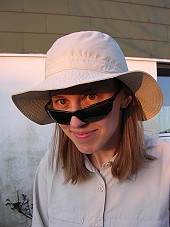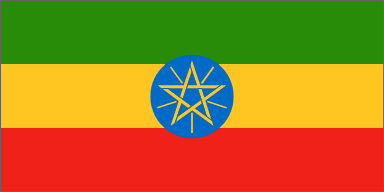
MARTINA'S WORLD TRIP
ETHIOPIA: May 18 - June 1, 2004


(Übersetzungshilfe)
 |
MARTINA'S WORLD TRIP ETHIOPIA: May 18 - June 1, 2004 |
|||||||
 |
||||||||
 |
Your Dictionary
(Übersetzungshilfe) |
|||||||
| Friday, May 28th, 2004 - Omo Valley Tour Day VII | |||||||
| Friday, May 28th, 2004 Omo Valley Tour Day VII (Dorze, Chencha & Arba Minch)
The day started with a switch between Mike and Nati who came to Konso and became our driver / guide for the rest of the tour. I must admit that we weren’t too sad to give up on Mike. He was an excellent driver and got us through every water hole, perfectly mastering the bumpiest road, but as a guide – he sucked. He never explained us anything, gave vague or invented answers when we asked him a question, often simply left without telling us where he went or when he would be back, and most of the time hung out with his friends instead of showing us around the places we visited. Once he refused to take other travellers onboard who asked us for a ride, saying that he couldn’t let anyone else in the car, which would have made sense, but then we saw him driving around with someone else in the car in Jinka! Unfortunately, with Mike we also swapped cars and the one we got with Nati was by far not as comfortable. Mike went back for another tour in the Omo Valley, whereas Nati was supposed to return to Addis Ababa with us. By this time I had almost decided not to continue to Kenya overland but to go back to Addis and fly southwards from there. I had met enough travellers, including very experienced people, who had all warned me that the north of Kenya was not safe these days. Groups of armed rebels had attacked travellers, regardless of whether they travelled in convoy or were accompanied by military guards. Most popular was the story of two Swedish guys who had lost everything but their underwear and had to be picked up by their embassy. The thing with stories like this is that you never know whether they are true or just legends that someone invented to scare off people like me. Either way, I was not in the mood to find out. Once in the car with Nati, we soon arrived in Arba Minch and as we had a lot of time today, he suggested to visit two other villages nearby. Dorze and Chencha are located in the Guge Mountains, 36km north of Arba Minch. Some of Ethiopia’s best woven cotton comes from Chencha and the Dorze people are famous for their huts. Standing up to 12m high, they resemble giant beehives. Constructed with vertical hardwood poles and woven bamboo, they are topped with a thatched roof of enset leaves. Though fragile-looking, a hut can last up to 60 years. Thanks to the vertical poles that make up the structure, the hut is easily transported to a new location. Most Dorze huts also boats their own little garden containing vegetables, spices and tobacco, as well as enset plantations. Enset trees, also known as “false banana”, resemble a single-stemmed banana plant. This ancient plant has been cultivated in Ethiopia for millennia and is eaten by over a third of the population. A little excursion on enset? Lonely Planet reports the following which is quite interesting: “The preparation of enset for cooking is a laborious process. After the plant is cut, it must be trimmed and scraped to remove all excess fibre, then chopped and beaten into a starchy white pulp (often seen for sale at markets). Finally, the plant is buried in an underground pit and allowed to ferment for at least a month. And the final result? For the uninitiated traveller, a kind of sticky, unleavened bread that closely resembles a fibrous carpet liner. It also makes a very chewy porridge. (...) Enset can be stored for up to 20 years, providing its cultivators with an emergency ration in times of hardship.” So we set off to Dorze and Chencha, climbing up some steep mountain roads that are certainly impassable after rain falls. But the journey affords some spectacular views over the Rift Valley lakes Chamo and Abaya and is worthwhile in itself. Famous for their woven cotton, the road is lined with colourful stands where people sell ‘shammas’ (cotton togas) and ‘gabis’ (thicker shammas). First, we went up to Chencha and visited the hut of a local family. It was a huge beehive structure and very interesting to see from the inside. First of all, it was pitch-dark and the only way to light it up, was to make a fire which usually led to the problem of smoke inside the house, so it was only done on rare occasions. Instead, we used our torches and our eyes had to get used to the darkness before we could actually see much. The hut was divided into different ‘rooms’: the “kitchen” close to the entrance (a simple cooking area with a stone circle surrounding warm ashes), to the left the “children’s bedroom” (a small spot covered with untidy sheets and pieces of cloth), and further inside the “living room” with simple mats on the floor where the adults could sit and sleep. There were a few more things stored towards the back of the hut but it was too dark to figure out what exactly was there. Towards the right hand side, a wall separated the living room from the cowshed in which some cattle lived under the same roof as the family. In total, at least 5 adults, 1 teenager and 1 child lived in the hut, with another baby on the way. Outside, within the fenced area surrounding their beautiful garden, there were two more huts, much smaller than the big one. One of them was used as the father’s weaver workshop where he showed us how he made cotton togas. Traditionally, it’s the men who weave and the women who spin. The family was very kind and generous, showing us around their premises, which we highly appreciated (although of course we had to pay for it). After the visit, we went back the same road down the mountain but stopped on the way at one of the street stalls to buy some ‘shammas’ and ‘gabis’. Since then, the pink-red-&-orange one I bought here got loads of compliments! In the early afternoon we arrived in Arba Minch and first organised our hotel for the night. Pretty much like last time, everywhere we went was disgusting or the rooms were fully booked. I really wondered: By whom??? Arba Minch (which means ‘Forty Springs’ due to the many springs in this area) is definitely neither beautiful nor especially charming and we hardly saw any tourists around. At the end of our tour, we all agreed that Arba Minch is one of the least attractive places we’ve been to. Anyway, after spending at least an hour on hotel search, we finally ended up at a very new place which didn’t even have a name sign yet. Therefore, we only found it thanks to the help of a guy who didn’t even ask for money for helping us out. At this stage, this was something we already noticed with surprise. The hotel was middle class but totally appropriate and much cleaner than most of what Arba Minch has to offer. According to our schedule, we were supposed to go for a boat trip on Lake Chamo this afternoon to see Africa’s most impressive display of big crocodiles. Sunning themselves on the warm sand of the lakeshore, Arba Minch’s crocodiles are fat and famous. Unfortunately, the fisherman Nati usually works with asked 300 birr for the trip which was far more than we were willing to pay. So we tried to find some more people to join in order to share the cost. Not to bore you with details, I’m going to make a very long story short by simply saying that we spent the rest of the afternoon trying to organise this boat trip which in the end never happened. We even went to the lake, climbed over a suicidal footbridge and already sat in a boat but then there was not enough fuel in the tank... At least, I saw some crocodiles and my first real life sea eagle from the shore. So when we finally gave up at the end of the day, we ended up at Checolet Pastry, a small but popular pastry shop where you can eat cakes and have a drink on their terrace. Obviously, I was quenching my thirst with another Avocado Juice. Later that night, we had dinner at Soma Restaurant (same menu as last time) and went out at a local bar, together with Volker and Manuela, a couple that is currently travelling around the world on their motor bikes. One more memory of this day: the man who moved table at Soma Restaurant just for us to be able to sit together. He was already eating and the table was large enough for all of us, so we told him he could certainly stay, but he said something like we were guests in his country, so we should have the privilege to enjoy our dinner and have enough space at our table. We were touched by his gesture which was a very rare experience in Arba Minch. |
|||||||